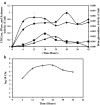Prospecting Agro-waste Cocktail: Supplementation for Cellulase Production by a Newly Isolated Thermophilic B. licheniformis 2D55
- PMID: 28176140
- PMCID: PMC5534209
- DOI: 10.1007/s12010-017-2401-z
Prospecting Agro-waste Cocktail: Supplementation for Cellulase Production by a Newly Isolated Thermophilic B. licheniformis 2D55
Abstract
Bacteria isolated from thermophilic environment that can produce cellulase as well as utilise agro-waste biomass have a high potential for developing thermostable cellulase required in the biofuel industry. The cost for cellulase represents a significant challenge in converting lignocellulose to fermentable sugars for biofuel production. Among three potential bacteria examined, Bacillus licheniformis 2D55 (accession no. KT799651) was found to produce the highest cellulolytic activity (CMCase 0.33 U/mL and FPase 0.09 U/mL) at 18-24 h fermentation when grown on microcrystalline cellulose (MCC) as a carbon source in shake flask at 50 °C. Cellulase production process was further conducted on the untreated and NaOH pretreated rice straw (RS), rice husk (RH), sugarcane bagasse (BAG) and empty fruit bunch (EFB). Untreated BAG produced the highest FPase (0.160 U/mL), while the highest CMCase (0.150 U/mL) was supported on the pretreated RH. The mixture of untreated BAG and pretreated RH as agro-waste cocktail has remarkably improved CMCase (3.7- and 1.4-fold) and FPase (2.5- and 11.5-fold) compared to the untreated BAG and pretreated RH, respectively. The mechanism of cellulase production explored through SEM analysis and the location of cellulase enzymes of the isolate was also presented. Agro-waste cocktail supplementation provides an alternative method for an efficient production of cellulase.
Keywords: Agro-waste cocktail; Cellulase production; Composting; Enzyme location; NaOH pretreatment; Scanning electron micrograph (SEM); Thermophilic bacteria.
Conflict of interest statement
The authors declare that they have no conflict of interest.
Figures








Similar articles
-
Saccharification of rice straw by cellulase from a local Trichoderma harzianum SNRS3 for biobutanol production.BMC Biotechnol. 2014 Dec 12;14:103. doi: 10.1186/s12896-014-0103-y. BMC Biotechnol. 2014. PMID: 25496491 Free PMC article.
-
Characterization of a thermophilic cellulase from Geobacillus sp. HTA426, an efficient cellulase-producer on alkali pretreated of lignocellulosic biomass.PLoS One. 2017 Apr 13;12(4):e0175004. doi: 10.1371/journal.pone.0175004. eCollection 2017. PLoS One. 2017. PMID: 28406925 Free PMC article.
-
Xylanases of Bacillus spp. isolated from ruminant dung as potential accessory enzymes for agro-waste saccharification.Lett Appl Microbiol. 2015 May;60(5):456-66. doi: 10.1111/lam.12397. Epub 2015 Feb 12. Lett Appl Microbiol. 2015. PMID: 25645626
-
Improved lignocellulose conversion to biofuels with thermophilic bacteria and thermostable enzymes.Bioresour Technol. 2013 Jan;128:751-9. doi: 10.1016/j.biortech.2012.10.145. Epub 2012 Nov 8. Bioresour Technol. 2013. PMID: 23246299 Review.
-
The eco-friendly approach of cocktail enzyme in agricultural waste treatment: A comprehensive review.Int J Biol Macromol. 2022 Jun 1;209(Pt B):1956-1974. doi: 10.1016/j.ijbiomac.2022.04.173. Epub 2022 Apr 30. Int J Biol Macromol. 2022. PMID: 35500773 Review.
Cited by
-
Screening of cellulolytic bacteria from rotten wood of Qinling (China) for biomass degradation and cloning of cellulases from Bacillus methylotrophicus.BMC Biotechnol. 2020 Jan 7;20(1):2. doi: 10.1186/s12896-019-0593-8. BMC Biotechnol. 2020. PMID: 31910834 Free PMC article.
-
Expression and characterisation of a thermophilic endo-1,4-β-glucanase from Sulfolobus shibatae of potential industrial application.Mol Biol Rep. 2018 Dec;45(6):2201-2211. doi: 10.1007/s11033-018-4381-7. Epub 2018 Sep 17. Mol Biol Rep. 2018. PMID: 30225584
-
Hemicellulosic biomass conversion by Moroccan hot spring Bacillus paralicheniformis CCMM B940 evidenced by glycoside hydrolase activities and whole genome sequencing.3 Biotech. 2021 Aug;11(8):379. doi: 10.1007/s13205-021-02919-0. Epub 2021 Jul 22. 3 Biotech. 2021. PMID: 34447652 Free PMC article.
-
Complete genome sequence of Bacillus velezensis 157 isolated from Eucommia ulmoides with pathogenic bacteria inhibiting and lignocellulolytic enzymes production by SSF.3 Biotech. 2018 Feb;8(2):114. doi: 10.1007/s13205-018-1125-2. Epub 2018 Feb 6. 3 Biotech. 2018. PMID: 29430375 Free PMC article.
-
Exploring the hemicellulolytic properties and safety of Bacillus paralicheniformis as stepping stone in the use of new fibrolytic beneficial microbes.Sci Rep. 2023 Dec 20;13(1):22785. doi: 10.1038/s41598-023-49724-8. Sci Rep. 2023. PMID: 38129471 Free PMC article.
References
-
- Yahya A, Sye CP, Ishola TA, Suryanto H. Effect of adding palm oil mill decanter cake slurry with regular turning operation on the composting process and quality of compost from oil palm empty fruit bunches. Bioresource Technology. 2010;101:8736–8741. doi: 10.1016/j.biortech.2010.05.073. - DOI - PubMed
-
- Shafie SM, Masjuki HH, Mahlia TMI. Rice straw supply chain for electricity generation in Malaysia: economical and environmental assessment. Applied Energy. 2014;135:299–308. doi: 10.1016/j.apenergy.2014.08.101. - DOI
-
- Sukumaran RK, Singhania RR, Pandey A. Microbial cellulases-production, applications and challenges. Journal of Scientific and Industrial Research. 2005;64:832.
-
- Ibrahim M, Razak M, Phang L, Hassan M, Abd-Aziz S. Crude cellulase from oil palm empty fruit bunch by Trichoderma asperellum UPM1 and Aspergillus fumigatus UPM2 for fermentable sugars production. Applied Biochemistry and Biotechnology. 2013;170:1320–1335. doi: 10.1007/s12010-013-0275-2. - DOI - PubMed
MeSH terms
Substances
LinkOut - more resources
Full Text Sources
Other Literature Sources

